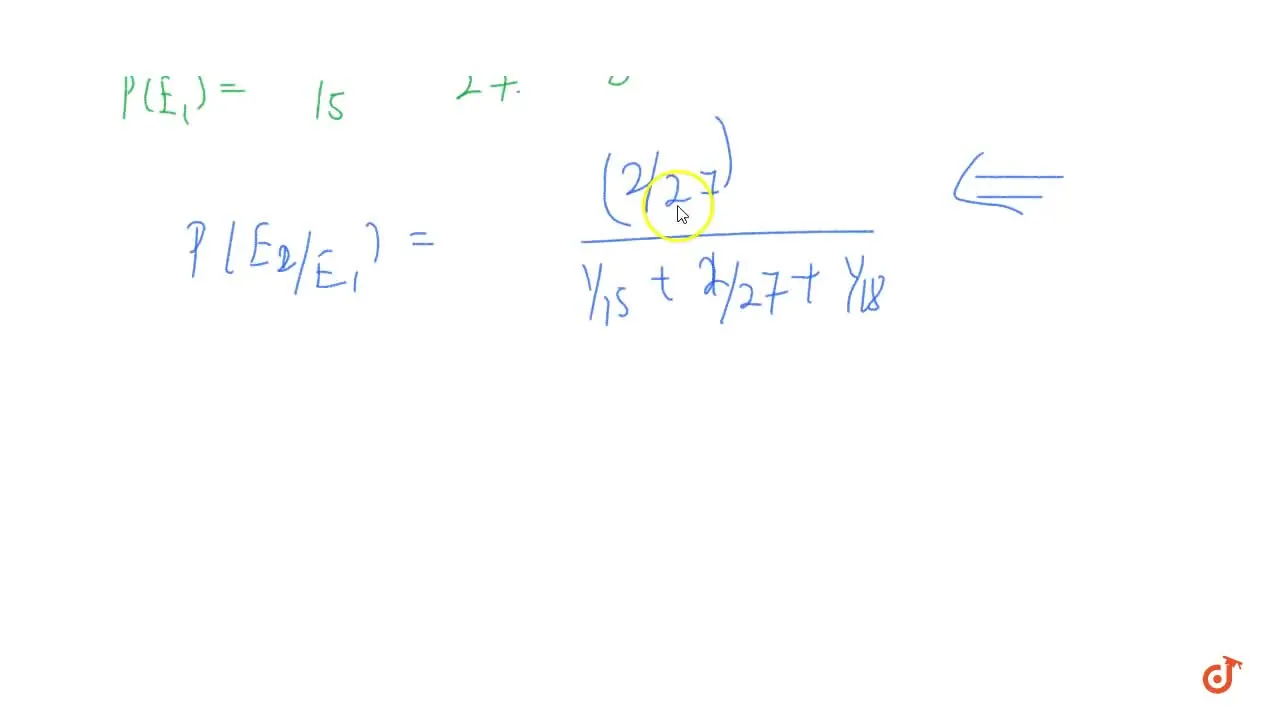Urn A contains 2 white, 1 black and 3 red balls, urn B contains 3 white, 2 black and 4 red balls and urn C contains 4 white, 3 black and 2 red balls. One urn is chosen at random and 2 balls are drawn at random from the urn. If the chosen balls happen to be red and black, what is the probability that both balls come from urn B?
Let E1 be the event that the urn A chosen.
E2 be the event that the urn B chosen.
And E3 be the event that the urn C chosen.
Thus, P(E1)=P(E2)=P(E3)=13
Let A be the event of drawing a red and a black ball.
Probability of drawing a red and a black ball from urn A,
⇒P(AE1)=15
Probability of drawing a red and a black ball from urn B,
⇒P(AE2)=29
Probability of drawing a red and a black ball from urn C,
⇒P(AE3)=16
Using Bayes theorem,
⇒P(E2A)=(13×29)(13×15+13×29+13×16)
=2053
Related Playlists
Similar Questions
Urn A contains 1 white, 2 black and 3 red balls, urn B contains 2 white, 1 black and 1 red balls, and urn C contains 4 white , 5 black and 3 red balls.
One urn is chosen at random and two balls are drawn. These happen to be one white and one red. What is the probability that they come from urn A?View SolutionBag I contains 2 white, 1 black and 3 red balls, Bag II contains 3 white, 2 black and 4 red balls, Bag III contains 4 white, 3 black and 2 red balls. A bag is chosen at random and two balls are drawn from it. They happen to be one black and one red. What is the probability that they come from bag II ?
View SolutionThere. are three boxes, the first one containing 1 white, 2 red -and 3 black balls, the second one containing 2 white, 3 red and 1 black ball and the third one containing 3 white, 1 red and 2 black balls. A box is chosen at random and from it two balls are drawn at random. One ball is red and the other, white. What is the probability that they come from the second box?
View SolutionAn urn contains 4 balls. Two balls are drawn at random from the urn (without replacement) and are found to be white. What is the probability that all the four balls in the urn are white ?
View SolutionThree identical Urns I, ll and III contain 4 white and 3 red balls, 3 white and 7 red balls and 2 white and 3 red balls respectively. An Urn is chosen at random and a ball is drawn out of it at random. If the ball is found to be white, what is the probability that Urn ll was selected?
View SolutionUrn A contains 7 white and 3 black balls, um B contains 4 white and 6 black balls, urn C contains 2 white and 8 black balls. One of these urns is chosen at random with probabilities 0.2, 0.6 and 0.2 respectively. From the chosen urn, two balls are drawn at random without replacement. Both the balls happen to be white. Find the probability that the balls drawn are from the urn C.
View SolutionThree urns, A, B, and C contain 6 red and 4 white ; 2 red and 6 white; and 1 red and 5 white balls respectively. An urn is chosen at random and a bal is drawn. If the ball drawn is found to be red, find the probability that the ball was drawn from urn A.
View SolutionThree urns contain 6 red, 4 black 4 red, 6 black and 5 red, 5 black balls respectively. One of the urns is selected at random and a ball is drawn from it. If the ball drawn is red, find the probability that it is drawn from the first urn.
View SolutionAn urn contains 4 white and 6 red balls. Four balls are drawn at random from the urn. Find the probability distribution of the number of white balls.
View SolutionAn urn contains 4 white and 6 red balls. Four balls are drawn at random from the urn. Find the probability distribution of the number of white balls.
View Solution


